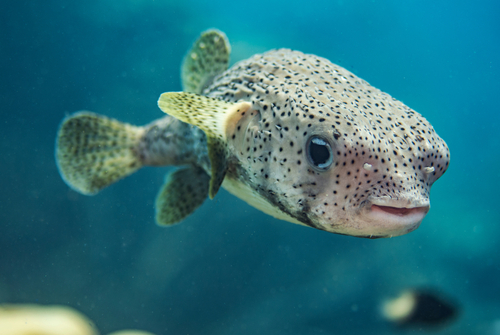When you’re looking for an exciting new fish to base your aquarium around there are few choices that are more intriguing than the Porcupine Puffer Fish but they are known to be a little complicated to care for. That’s why we’ve put together this list of the best Porcupine Puffer tank mates so that you can be sure you’re pairing your new friend up with the right roomies.
We’re going to let you know exactly what factors you need to consider and why we’ve selected each of these excellent options for you to choose between. When you get to the end you’ll be ready to start the ultimate community tank with no worries at all!
Contents
What You Have To Know – Porcupine Puffer Tank Mates
It’s no simple thing to move into a new home, especially if you’re sharing it with complete strangers. The same is definitely true for your fish. If you’re putting different species together, they will be living in very close quarters with one another for their entire lives so you need to be sure that they are going to be happy and friendly.
There are a lot of elements that you have to carefully consider when you’re deciding on the right tank mates for your Porcupine Puffer.
Personality and Temperament
One of the most significant considerations you should have when you’re looking at different fish is the kind of personality they have and how they tend to interact with other fish that they are housed with.
Porcupine Puffer Fish are generally quite easy going with other large fish but they are likely to nip at and even eat smaller fish, crustaceans, and invertebrates. You’re probably used to viewing shrimp as a very easy tank mate option but that is definitely not the case here!
As you might expect, Porcupine Puffers are pretty good at defending themselves, but they can become very unwell if they are stressed so you do not want to house them with a fish that will harass them or invade their space.
Porcupine Puffer Fish can be kept with others of the same species but they are not very social and will need a lot of space to stay away from each other so it is not recommended.
Full-Grown Size
Size is a big factor when it comes to putting different fish in the same tank and a general rule of thumb to follow is that a similar size is usually best.
Porcupine Puffers are big fish in the hobby world (growing to around 12 inches or longer on average) and, as we said before, any fish that is significantly smaller than they are can end up on the menu. Some smaller fish can be relatively safe as long as they are able to stay out of your Puffer’s way, but it is always a bit of a risk.
Equally, larger fish are likely to be more aggressive or domineering and cause your puffers to become anxious. While it is certainly impressive to watch a puffer puff, they only use this mechanism when they are feeling scared so it is not something that you want to witness often.
Tank and Parameters
Any new friends for your puffer will need to be able to thrive with the exact same water and tank setup that Porcupine Puffers like. Everything from the temperature to the hardness will greatly affect how healthy your fish are, and making a compromise for one species can cause a lot of harm to the other’s well being.
Porcupine Puffers like:
- Temperature: 75°F – 82°F (25°C – 28°C)
- Specific Gravity: 1.020 – 1.025
- Carbonate Hardness (dKH): 8 – 12°
- pH Level: 8.1 – 8.4
- Tank Size: Minimum 100 – 200 gallons
Competition for Resources
When you’re dealing with a fish of this size, the importance of sharing resources within the tank becomes even more significant. They need to have enough space for each individual to live comfortably, they need to be able to enjoy their environment without having to fight for it, and they need to be able to eat comfortably.
It is worth noting Porcupine Puffers are not considered safe for reef tanks. They will view almost any invertebrates and even corals as food so they simply won’t get along comfortably in a reef environment.
8 Top Porcupine Puffer Tank Mates
With all of that in mind, let’s take a look at some of the top choices out there for housing with your Porcupine Puffer!
You will also like these other top posts in this category:
1. Blue Tang
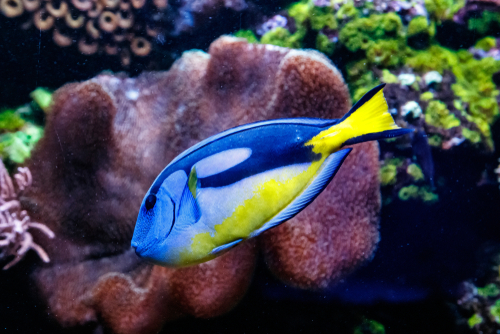
- Scientific Name: Paracanthurus hepatus
- Full-Grown Size: Approx. 12 inches
- Care Difficulty: Moderate
- Good Tank Mates: Clownfish, Gobies, Cardinalfish
- Place of Origin: Indo-Pacific
Made famous by the character of Dory in the film Finding Nemo, the Regal (or Royal) Blue Tang is one of the most striking and compatible potential tank mates for a Porcupine Puffer. They are the perfect size and temperament to get along without any kind of aggression and they look simply stunning.
They can be a little nervous so they need a lot of hiding spots to keep them from getting stressed, but this kind of tank setup will also suit your Porcupine Puffer, so it’s a win-win!
2. Purple Tang
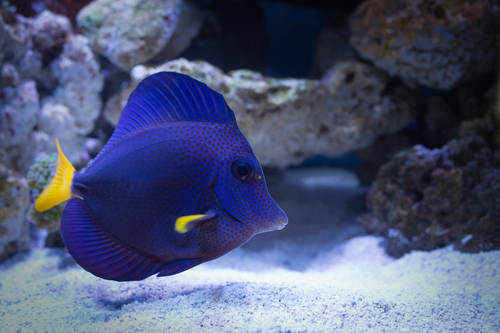
- Scientific Name: Zebrasoma xanthurum
- Full-Grown Size: Approx. 10 inches
- Care Difficulty: Moderate
- Good Tank Mates: Cardinalfish, Large Angels, Wrasses
- Place of Origin: Red Sea
The Blue Tang is not the only member of the Tang family that can be an excellent addition to a Porcupine Puffer tank, and the Purple or Yellowtail Tang is a popular alternate option. They have a rich color and delicate pattern that make them wonderful to look at, but they can be a bit of a challenge to care for.
They like a lot of open room to swim and explore and they can get a little aggressive if they feel cramped or crowded but they also want to have little crevices in live rock to hide in overnight. This is actually a positive for your Puffer as Porcupine Puffers are nocturnal feeders and will appreciate having some space when it’s dark out.
3. Six Line Wrasse
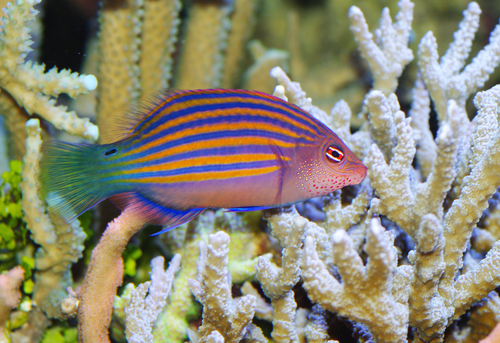
- Scientific Name: Pseudocheilinus hexataenia
- Full-Grown Size: Approx. 4 inche
- Care Difficulty: Easy
- Good Tank Mates: Other Wrasse, Clownfish, Tangs
- Place of Origin: Indo-Pacific
These fish are one of the most popular saltwater species that you will find in stores or online, and for good reason. They are interesting, beautiful, and they are pretty hardy too.
While the Six Line Wrasse is certainly on the smaller side. These fish are known for their speed and won’t allow themselves to be nipped at so they are usually pretty safe in a tank with a Porcupine Puffer. They are actually known to be quite aggressive, but the size difference will stop them from going after your Puffer.
4. Bristletooth / Tomini Surgeonfish
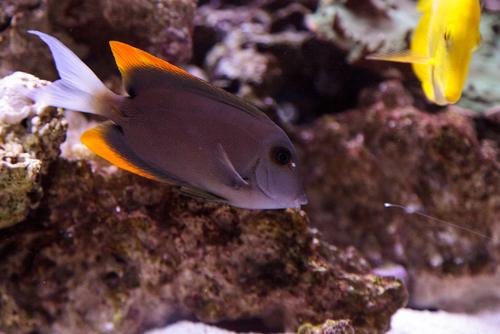
- Scientific Name: Ctenochaetus tominiensis
- Full-Grown Size: 6 – 8 inches
- Care Difficulty: Easy
- Good Tank Mates: Gobbies, Clownfish, Angelfish
- Place of Origin: Indo-Pacific
These fish are also part of the wider Tang family and they are sometimes known as the Bristletooth Tomini Tang and the Flame Fin Tang. In comparison to some of their family members, they are relatively easy to care for. They are speedy and quirky and the bright orange tips to their fins certainly make them stand out.
They are calm and keep themselves to themselves most of the time. Though they can get a little aggressive with new fish, they will settle down over time and start to get along.
5. Snowflake Eel
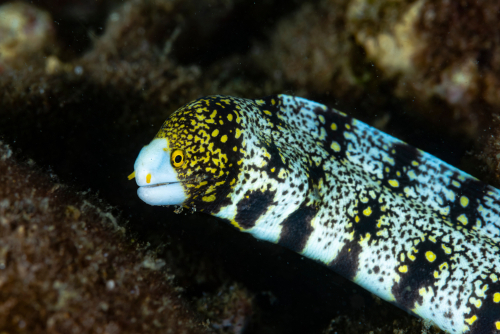
- Scientific Name: Echidna nebulosa
- Full-Grown Size: Approx. 24 inches in captivity
- Care Difficulty: Intermediate
- Good Tank Mates: Lionfish, Tangs, Wrasses
- Place of Origin: Indo-Pacific
If you’re looking for something truly different to move in with your Puffer then look no further than the Snowflake Eel. Perhaps the most mesmerizing and attractive of all the compatible eel species, a Snowflake will usually get along well with larger fish that stay out of their way.
They will spend most of their time hiding amongst the rocks but they do like to move around as well. Much like your Puffer, they tend to view smaller fish as food – and they are known to be particularly talented escape artists so you will want to have a tight-fitting canopy!
6. Squirrelfish
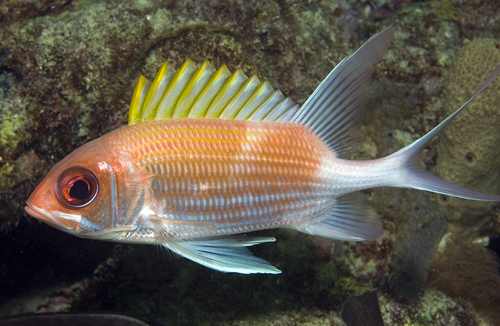
- Scientific Name: Holocentrus adscensionis
- Full-Grown Size: 6 – 10 inches
- Care Difficulty: Intermediate
- Good Tank Mates: Angelfish, Tangs, Clownfish
- Place of Origin: Indo-West Pacific
Squirrelfish might be a little smaller than your Puffer but their intimidating dorsal fin and tendency to run from a confrontation will usually keep them safe living in the same tank. These fish have massive black eyes which gives them their unique name, and they develop strong coloring as they get older.
These are a hardy kind of fish too, and they are not too choosy about life in a tank as long as they have plenty of room to move around in and some good hiding spots to dart into.
7. Engineer Gobies
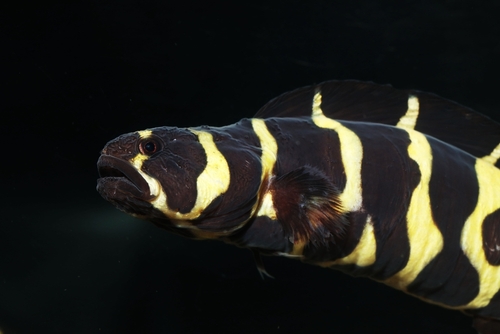
- Scientific Name: Pholidichthys leucotaenia
- Full-Grown Size: Approx. 13 inches
- Care Difficulty: Intermediate
- Good Tank Mates: Damselfish, Angelfish, Tangs
- Place of Origin: West-Central Pacific
The Engineer Goby is a surprisingly underappreciated saltwater option as they have a wonderfully unique appearance and great personalities. They are generally outgoing but peaceful with a lot of interesting quirks so they definitely stand out.
These fish have long, eel-like bodies and a pattern that’s somewhere between that of a giraffe and a zebra. They like to burrow and they may well try and make a break from the tank so make sure that it is nice and secure!
8. Foxface fish
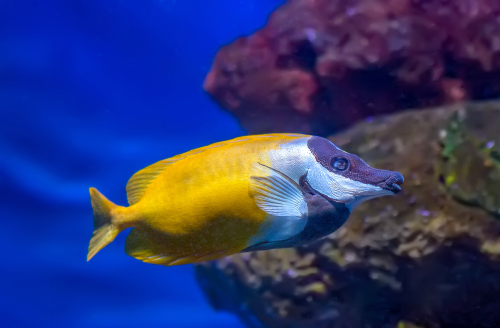
- Scientific Name: Siganus vulpinus
- Full-Grown Size: Approx. 10 inches
- Care Difficulty: Moderate
- Good Tank Mates: Angelfish, Parrotfish, Wrasses
- Place of Origin: Western Pacific
It should come as no surprise that this fish has a pretty peculiar visage. The Foxface fish, or Foxface Rabbitfish, gets its name from its unique facial structure but they are also very striking due to their bright yellow, white, and black coloring and their stunning fins.
They are peaceful herbivores that should stay well away from your Porcupine Puffer and, just like your Puffer, they are known coral nippers so they are not suitable for reef setups. They are very fond of algae so these fish are also great for keeping the tank clean!
Summary: Best Tank Mates For Porcupine Puffers
So, who would make the best tank mates for a Porcupine Puffer? Well, you should be looking for a similar-sized fish that is not too aggressive and likes to keep to its own space. Fish that are too small could end up becoming a meal and fish that are too big and confrontational can cause your Puffer too much stress.
Many types of Tangs are ideal for living alongside Porcupine Puffers, as are larger Wrasses, but you could also opt for something a little more unique like a Snowflake Eel, an Engineer Goby, or a Foxface Rabbitfish.

Ian Sterling, founder of Fishlab.com, began his aquarium journey over 30 years ago, driven by a deep fascination for fish and their diverse personalities. His website, Fishlab.com, is dedicated to making fishkeeping accessible and enjoyable, offering beginner-friendly guidance, expert insights, and a community for aquarists to connect and share experiences.


